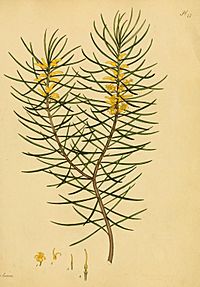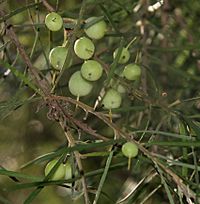Narrow-leaved geebung facts for kids
Quick facts for kids Narrow-leaved geebung |
|
|---|---|
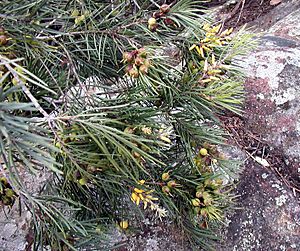 |
|
| Scientific classification | |
| Genus: |
Persoonia
|
| Species: |
linearis
|
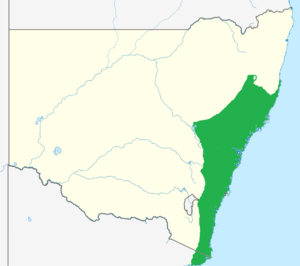 |
|
| Range of P. linearis in New South Wales and extending into Victoria in eastern Australia | |
| Synonyms | |
|
List
Persoonia phyllostachys Gand.
Persoonia breviuscula Gand. |
|
The narrow-leaved geebung (Persoonia linearis) is a type of shrub or small tree. It grows naturally in New South Wales and Victoria, which are states in eastern Australia. This plant can reach about 3 meters (10 feet) tall, but sometimes grows up to 5 meters (16 feet). It has thick, dark grey bark that feels like paper.
Its leaves are long and thin, like lines, which is why it's called "linearis." They can be up to 9 cm (3.5 inches) long. Small yellow flowers appear from summer through early winter (December to July). After the flowers, the plant grows small, green, fleshy fruits called drupes. The narrow-leaved geebung is part of a group of 58 closely related Persoonia species. It can even mix with other Persoonia species where they grow close together.
This plant lives in dry sclerophyll forests, which have tough, leathery-leaved plants. These forests often have sandy, poor soils. The narrow-leaved geebung is good at surviving bushfires. It can regrow from special buds hidden under its thick bark. Animals like kangaroos, possums, and currawongs eat its fruit. It's not often grown in gardens because it's hard to start from seeds or cuttings. However, once it starts growing, it's quite tough. It likes acidic soils that drain well and sunny spots.
Contents
About the Narrow-leaved Geebung
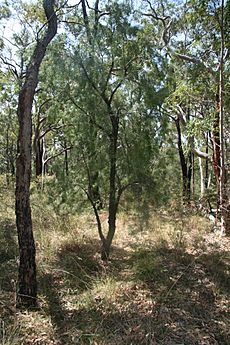
The narrow-leaved geebung was first described in 1799 by an English botanist and artist named Henry Cranke Andrews. He wrote about it in his book Botanists Repository. He got a flowering plant from J. Robertson, who had grown it from a seed in 1794. The plant's scientific name, linearis, comes from the Latin word for "linear" or "line-like." This refers to the shape of its leaves.
Over the years, other botanists gave this plant different names, but Andrews' name was the first and stuck. The common name "geebung" comes from the Dharug language, spoken by Aboriginal people in the Sydney area. They used the word geebung or jibbong for the fruits of this plant. Another Aboriginal name for it from the Illawarra region is Naam-burra.
Botanists group Persoonia linearis with 54 other similar species. These species have similar flowers but different leaves. They often create hybrids (mixes) when they grow near each other. For example, hybrids with P. lanceolata and P. pinifolia have been found.
What the Plant Looks Like
The narrow-leaved geebung usually grows as a tall shrub, about 2 to 3 meters (6.5 to 10 feet) high. Sometimes it can grow into a small tree up to 5 meters (16 feet) tall. Its bark is soft and flaky, dark grey on the outside and reddish inside. This bark helps protect the plant. When there's a bushfire, special buds under the bark can sprout new growth. Young shoots are a bit hairy.
The leaves are long and narrow, from 2 to 9 cm (0.8 to 3.5 inches) long and 0.1 to 0.7 cm (0.04 to 0.3 inches) wide. Their edges are slightly rolled downwards.
Yellow flowers bloom in summer, autumn, and early winter (December to July), with the most flowers appearing in January and February. The flowers grow in clusters along leafy stems. Each stem can have up to 50 flowers. Each flower hangs on a short stalk, about 2–8 mm long, covered in fine hairs.
Each flower has a tube-shaped outer part called a perianth, made of fused tepals. Inside are both male and female parts. The tepals are 0.9–1.4 cm long and hairy on the outside. The central part is the style, which has the stigma (where pollen lands) at its tip. Around the style are the anthers (male parts), which split into four parts that curl back. These curled parts look like a cross and give insects a place to land.
After flowering, the plant produces smooth, fleshy, green drupes. These fruits are round, about 1.3 cm (0.5 inches) across. When they are fully ripe, they might have purple spots. Each fruit holds one or two seeds inside a hard, woody "stone." The fruits usually drop from the plant between September and November.
Where it Grows
The narrow-leaved geebung is one of the most common geebungs. It can be found from the Macleay River area in New South Wales down to the Tambo River in eastern Victoria. It grows from sea level up to 1000 meters (3,300 feet) high. This plant needs about 700 to 1400 mm (27 to 55 inches) of rain each year.
It grows in dry sclerophyll forests, both on sandy and clay soils. It likes sunny or lightly shaded spots in open forests or woodlands with a lot of shrubs underneath. In the Sydney Basin, it often grows with trees like Sydney peppermint, silvertop ash, and blackbutt. It also grows with other shrubs like Grevillea obtusiflora and stiff geebung.
Near Nowra and Jervis Bay, it's part of the understory (the plants growing under the main trees) in the Currambene Lowlands Forest. Here, it grows with plants like gorse bitter pea and native daphne, under trees such as spotted gum and white stringybark. These forests are usually on hilly land with good drainage. The soil is often a yellow loam made from mudstone, siltstone, and sandstone.
Life Cycle and Ecology
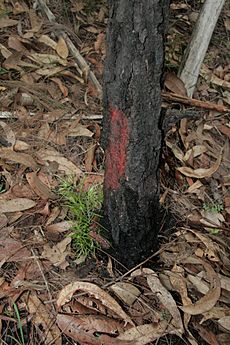
The narrow-leaved geebung is special because it can regrow after bushfires. This is an important adaptation for plants in Australia, where fires are common. It resprouts from its trunk or stems that are thicker than 2 cm (0.8 inches). Its thick, papery bark protects the hidden buds from the flames. Even after very hot fires, larger trunks (12–16 cm wide) can survive and sprout new growth. The plant can also regrow from its base if the main stem is killed.
Tiny bees from the Leioproctus genus are very important for pollinating Persoonia flowers. They visit the flowers to collect food and help the plants make seeds.
The fruits of the narrow-leaved geebung weigh about 1900 mg (0.07 oz). They are designed to be eaten by larger animals like kangaroos, possums, and large birds such as currawongs. The seeds have even been found in the droppings of brush-tailed rock-wallabys. This helps spread the seeds to new places.
Growing the Plant
The narrow-leaved geebung can be a good plant for hedges in gardens because it responds well to pruning (trimming). Its leaves are also used in flower arrangements, and its colorful bark makes it an attractive plant.
It's fairly easy to grow in a garden once it's established. However, it's not often seen because it's hard to start new plants. Getting seeds to sprout is difficult and can take many months. While it was once thought that cuttings could be used, this is also tricky.
Once it's growing, it can handle long dry periods and is tough against frosts. It grows best in partial shade and acidic soil that drains well, but it can also grow in full sun. Persoonia plants generally don't like too much phosphorus (a nutrient often found in fertilizers). They grow well without fertilizer or with special low-phosphorus slow-release fertilizers. Sometimes, they might need extra iron or manganese.
The narrow-leaved geebung was first grown in England in 1794 from seeds. Early growers noted it was a "handsome greenhouse plant" that flowered through autumn and produced good seeds.


